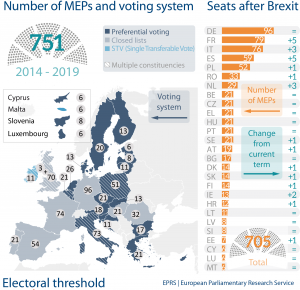The outgoing EP has 751 MEPs (the maximum possible under Article 14(2) TEU). With the United Kingdom now expected to take part in the 2019 elections, the number of Members to be elected in each Member State will be the same as in 2014. Nonetheless, once the United Kingdom does withdraw from the EU, some of the seats held by Members elected there will be redistributed among other Member States, and the overall total number of seats reduced to 705. The Member States concerned are expected to make provision for those extra seats at this year’s elections, even if there is no certainty as to when those Members will take up their seats. (This situation is similar to that in December 2011, when 18 additional Members joined the Parliament in mid-term, as a result of the ratification of the Lisbon Treaty, altering Parliament’s composition, after the 2009 elections.)
MEPs are elected according to national electoral systems, but these have to observe certain common provisions established by EU law, such as proportional representation. As a general rule, voters can choose between political parties, individual candidates or both. While in some Member States, voters can only vote for a list, without the possibility to change the order of candidates on the list (closed list), in other Member States voters can express their preference for one or more of the candidates (preferential voting). Depending on the degree of freedom voters enjoy when casting their preferential vote, one can distinguish between semi-open lists, where voters can change the position of one or all candidates on a single chosen list, and open lists, where voters can vote for candidates from different lists. Instead of a list system, some Member States use the single transferable vote (STV). Under this system, the voter has one vote but can rank the candidates in order of their first, second, third, etc. choice. To be elected, a candidate needs to receive a minimum number of votes.








Be the first to write a comment.